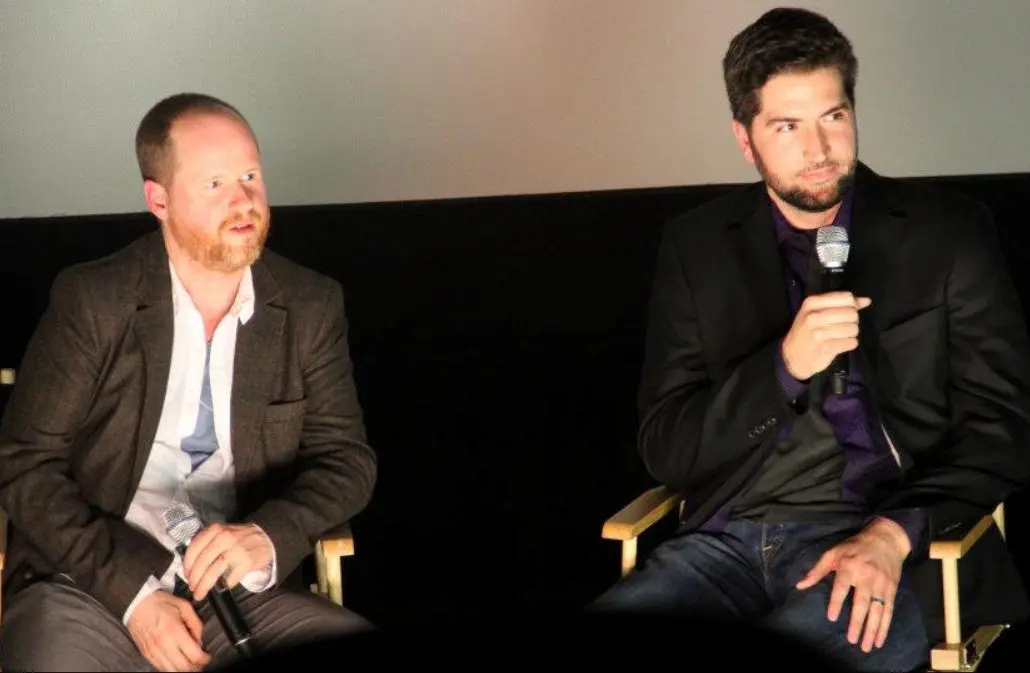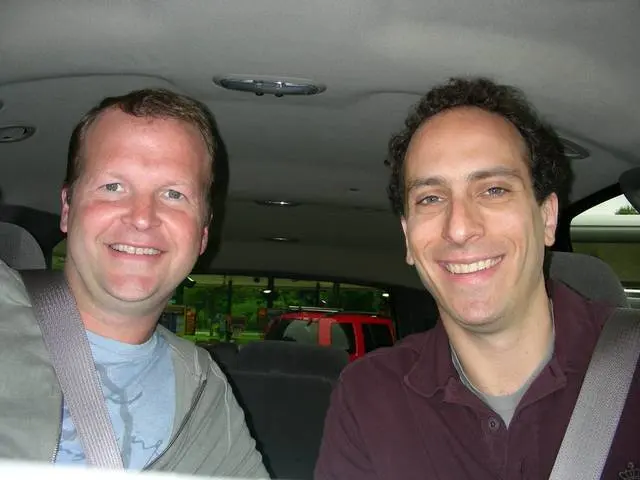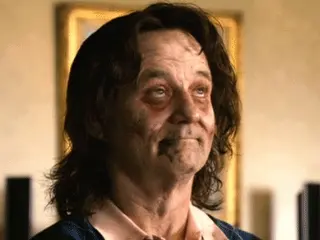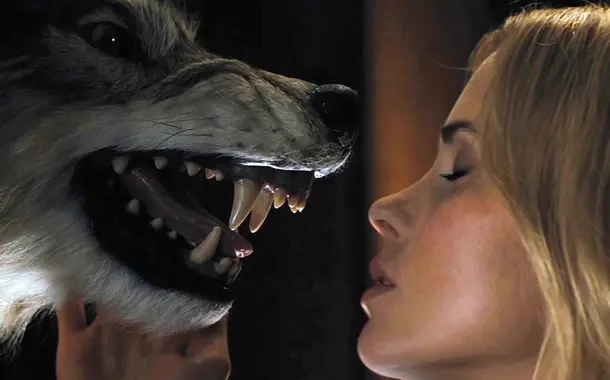The best horror stories make you keep on suspecting that this can’t possibly go on. That things have already reached their bloody crescendo, have hit that point past which any reasonable story is going to have run out of gas.
That’s right about when Cabin in the Woods starts picking up speed.
There’s an exuberance here that you see very, very rarely at the cineplex. At the film festivals, sure, sometimes. From Sam Raimi or Wes Craven: more often than not. In your treasured DVD collection: hopefully. But Cabin in the Woods is something you don’t have on your shelf. That tagline on the poster, You think you know the story? I did think I knew the story.
Group of mismatched not-naked-yet college types loading into an RV, trekking out into the woods for some Savage Weekend action? It’s every horror movie from Just Before Dawn to Severance. It’s Kill Theory through a Tucker & Dale vs. Evil filter, with some Cabin Fever goodness thrown in. I mean, where does The Texas Chain Saw Massacre start if not with some kids in a van, driving out into the sticks? And if The Hills Have Eyes and AMC’s The Walking Dead have taught us anything, it’s that people in RVs only take Wrong Turns. Like Crazy Ralph said once upon a time: they’re doomed.
And, of course we’ve all seen the trailer already, but in case any of you are just climbing out of a cave:
The Rubik’s Cube Monster House from Thief of Always is no-doubt cool, but does anybody recognize that massive Raccoon City sub-basement? It’s direct from that Rock-remake of Escape from Witch Mountain. Except here, by the time the elevator doors open, all the kids have gone to bed: there’s those walls of blood The Shining have trained us to love. And please be very very aware that, for reasons of non-spoilage, they can’t show us the super supercool stuff in that trailer. I mean, what’s there’s cool enough, definitely. But it goes beyond. As one of the Heathers might have said: it’s very.
So, by way of pre-synopsis, walking into the theater you know that these strangely beautiful kids aren’t just going to die, they’re going to die slasher-style, which is to say we’ll tease them apart and sacrifice them one by one, give them each a set-piece kind of death. And there’ll be humor along the way (horror needs its pressure-release valves), there’ll be some version of Scream’s Randy, we’ll see some skin—eye candy for all—and, finally, one plucky member of these willing victims will come into his or her own, go Ripley on the bad guys, maybe even live to see the sequel, start the franchise.
It’s the rollercoaster horror story we know and love. It’s a time-honored gospel. Jason and Freddy and Michael and Ghostface all go to this particular church. Even Chucky lowers his head in prayer. I mean, leprechauns take a knee. Can Cabin in the Woods sing from a different hymnal, finally?
 Yes. Specifically because of that whole tradition. Joss Whedon and Drew Goddard, they know and love all those movies as well. Obviously. After the film, Drew Goddard was saying how this was his and Whedon’s love letter to the genre. And it shows. And it’s written in blood, as it has to be.
Yes. Specifically because of that whole tradition. Joss Whedon and Drew Goddard, they know and love all those movies as well. Obviously. After the film, Drew Goddard was saying how this was his and Whedon’s love letter to the genre. And it shows. And it’s written in blood, as it has to be.
However.
Watch enough of these teenybopper stalk & slash numbers in a row, and what you come away with—what you’re hardly surprised to come away with—is that, as Kevin Williamson told us, they’re all variations on a theme. A very good and important theme, one that seems to be programmed into our brainstem, but still, Goddard and Whedon, they’re hardly content to just walk demurely in John Carpenter’s footsteps. The meek don’t inherit the box office. And this isn’t that complaint critics are always lobbing at contemporary horror, from Hostel to Saw to I Saw the Devil, that today’s horror films aren’t subtle enough, that they’re all loud and fast music videos, that they’ve forgotten the dreadwork you can do with shadows and atmosphere and properly-arched eyebrows.
No, Goddard and Whedon, they have a pretty solid handle on this particular strain of dreadwork: they understand that where it happens, it’s in the script, it’s in the story. The trick with adrenaline-rush kind of horror, though, the kind that never lets up, even to get popcorn, it’s that persistent escalation gets you up the story’s mountain too fast, then launches you out into the void of the ridiculous, the contrived, the unbelievable. Which is to say the scare goes away. We’ve seen it happen time and again, enough that I don’t need to name names.
Still, when two guys of this caliber, with their kind of pedigrees—again, I hardly need to name titles—when they set down to pen a horror story, it’s not enough to just make all the necessary genre nods while trying to redo Scream in such a way that nobody calls them on it.
Really, the way I see them at their writing table, it’s this:
With Cabin in the Woods, they didn’t just make one horror movie. They made them all.
Seriously.
 Yes, like the rest of your video shelf does, they force their characters through a meatgrinder of a narrative, and are just as heartless with them as they need to be, as we're paying for them to be, but, as counterpoint, as brilliant, inspired pacing device—you know those two guys from the Sonic commercials? Well, without giving anything away, their Office Space versions are here, working deep in the bowels of the beauracrcy of fear, providing a running banter to keep things from ever even starting to drag.
Yes, like the rest of your video shelf does, they force their characters through a meatgrinder of a narrative, and are just as heartless with them as they need to be, as we're paying for them to be, but, as counterpoint, as brilliant, inspired pacing device—you know those two guys from the Sonic commercials? Well, without giving anything away, their Office Space versions are here, working deep in the bowels of the beauracrcy of fear, providing a running banter to keep things from ever even starting to drag.
How? Can’t say. Or, won't. Dr. Claire Saunders is there, if that helps. I can say that for any good movie like this, it takes a village. And I’m not talking about Goddard’s crew, though they were obviously on-task. I’m talking about the story. How about this: in the Q&A (this was Boulder, the tour’s last stop), Goddard might have, I don’t know . . . invoked Cthulhu? Maybe in response to an unrelated question, of course. And maybe not.
There’s even more going on too, though. Yes, obviously Whedon and Goddard are commenting on the internal dynamics of the horror movie, and trying to revitalize any genre fatigue that might be happening, remake by remake. But they’re also commenting on the whole horror genre itself. Big picture, I’m saying. One we’re all in. One we were born into.
Why do we return to see these same people die again and again? Once makes a sick kind of sense, at least if gratuitous violence and splatter comedy are your thing. But over and over? There must be a reason.
There is.
Ask Cabin in the Woods. It knows. It shows us. In as Clive Barker a way as possible. Which is to say In the best way possible.
But perhaps the best recommendation I can finally give Cabin in the Woods, it’s that what we’re seeing on the screen, in the theatre, it already feels like a director’s cut. Like every bit of fun Whedon and Goddard wanted to have, they’re having it up there. And every frame of it’s absolutely necessary. Cabin in the Woods, it’s got the potential to be a game-changer. If it hits like it should, like it deserves to, it can send the studios to their slushpiles, to see what they can cash in on, what they've been ignoring too long. But, unlike the brief renaissance Scream provoked, I don’t see Cabin in the Woods getting cloned again and again. Some movies—Taxi Driver, Blue Velvet—are so much their own thing that they can’t be copied. But they can influence a generation. They can insert their DNA into every movie that comes after. They can be a big reset button, and a model of what can be done, if you really try. If you really really want it. If you believe.
Cabin in the Woods makes you believe.
 And, if that’s not enough, then—and you have to trust me on this, and don’t don’t don’t let anybody spoil it for you—let me just say that, until now, the best cameo ever was probably Bill Murray in Zombieland. Yes?
And, if that’s not enough, then—and you have to trust me on this, and don’t don’t don’t let anybody spoil it for you—let me just say that, until now, the best cameo ever was probably Bill Murray in Zombieland. Yes?
Or, the best cameo ever, it used to be Bill Murray all zombied up.
Cabin in the Woods goes it one better, though. You’ll see. You’ll clap, you’ll smile, and there’ll probably even be tears in your eyes by then. Of joy.
As far as I’m concerned, Cabin in the Woods is the most important horror movie of this kind since 1996. Since my own holy grail, Scream. Cabin in the Woods takes all that genre-awareness, though, all the obligatory tropes and clichés, the nods and knowing grins, and then it rushes us all the way back to Evil Dead, by way of The Thing, say. And can there be anything more chocolate and peanut butter in the horror world than that?
If you don’t see this movie in the theater, you’re missing an event. Then, like the summer of ’81, you can come back for more, friends in tow, just to watch them scream from this dead kid exploding up from the water once and forever, and your box office receipts can usher in a new little golden age of horror, of innovation and competition, of excess and wonderful accidents. Stars will be born and stars will die, in every way Tom Savini could have imagined, and maybe even more.
The blood will slosh from wall to wall.
Let’s ride it as long as we can.
[ could be a spoiler in these tags, for those with the eyes to see. be wary ]
-
![best wolf kiss EVER]() synopsis-via-tags: Deliverance→Half-Baked→Children Shouldn’t Play with Dead Things→Showgirls;→Truman Show→House of 1000 Corpses→Monsters, Inc. →Communion→The Adjustment Bureau→Monsters vs. Aliens→Hellboy→Carrie
synopsis-via-tags: Deliverance→Half-Baked→Children Shouldn’t Play with Dead Things→Showgirls;→Truman Show→House of 1000 Corpses→Monsters, Inc. →Communion→The Adjustment Bureau→Monsters vs. Aliens→Hellboy→Carrie
What movies would you tag Cabin in the Woods with? What—even just working off the trailer—do you see as its predecessors, its contemporaries, its challengers? Does it have a chance of starting something new again with horror?

About the author
Stephen Graham Jones has ten novels and more than a hundred and thirty short stories published, and has been teaching fiction for twelve years. 2012 will see at least two more novels from him, then at least one in 2013 and one in 2014, he says, "should the world not have ended by then."
Stephen Graham Jones' recent few books are Zombie Bake-Off, Seven Spanish Angels, It Came from Del Rio, and the Stoker finalist The Ones That Got Away. Next are Growing up Dead in Texas (MP Publishing), Flushboy (Dzanc), and Zombie Sharks with Metal Teeth (Lazy Fascist). The last few anthologies he's in are The Weird, Amazing Stories of the Flying Spaghetti Monster, Creatures, and West of 98. Jones teaches in the MFA program at CU Boulder. More at http://demontheory.net.


 synopsis-via-tags: Deliverance→Half-Baked→Children Shouldn’t Play with Dead Things→Showgirls;→Truman Show→House of 1000 Corpses→Monsters, Inc. →Communion→The Adjustment Bureau→Monsters vs. Aliens→Hellboy→Carrie
synopsis-via-tags: Deliverance→Half-Baked→Children Shouldn’t Play with Dead Things→Showgirls;→Truman Show→House of 1000 Corpses→Monsters, Inc. →Communion→The Adjustment Bureau→Monsters vs. Aliens→Hellboy→Carrie







